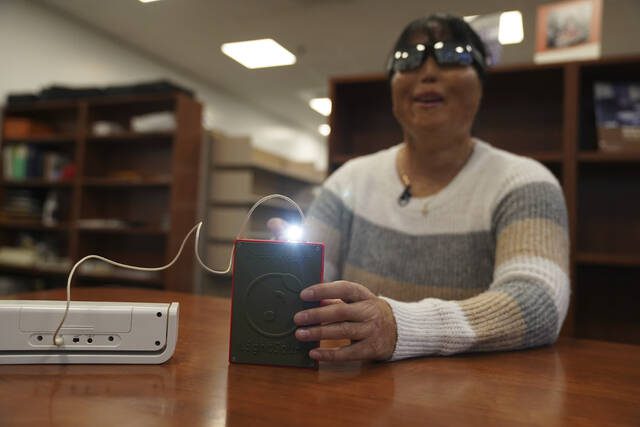WASHINGTON — As people watch the eclipse, those who are blind or have vision problems can hear and feel the celestial event.
Devices that use sound and touch will be provided at gatherings on April 8 when a total solar eclipse passes over North America, with the moon covering the sun for a short time.
Yuki Hatch, a high school senior in Austin, Texas, who is visually impaired, believes everyone should be able to witness an eclipse at least once in their lifetime.
Hatch, a visually impaired student and space enthusiast with dreams of becoming a NASA computer scientist, and her classmates at the Texas School for the Blind and Visually Impaired plan to sit outside and listen to a small device called a LightSound box that converts changing light into sounds.
When the sun is bright, delicate flute notes will be heard. As the moon starts to cover the sun, the sound will transition to mid-range notes resembling a clarinet. Darkness will be represented by a low clicking sound.
Hatch is excited about the opportunity to hear the eclipse rather than seeing it.
The LightSound device is a result of collaboration between Wanda Díaz-Merced, a blind astronomer, and Harvard astronomer Allyson Bieryla. Díaz-Merced uses audio translations of her data for research purposes.
The prototype was first used during the 2017 total solar eclipse in the U.S. and has been used at other eclipses. They are working with other institutions to distribute at least 750 devices for eclipse events in Mexico, the U.S., and Canada.
This year, they are collaborating with various institutions to distribute at least 750 devices to locations hosting eclipse events in Mexico, the U.S., and Canada. They conducted workshops to build the devices and provided DIY instructions on their website.
Díaz-Merced emphasized the importance of making the eclipse accessible to the blind, stating, “I want students to be able to hear the eclipse, to hear the stars.”
The Perkins Library, associated with the Perkins School for the Blind in Watertown, Massachusetts, plans to stream the changing tones of the LightSound device over Zoom for members to listen online and by telephone, according to outreach manager Erin Fragola.
The library's senior patrons who have vision loss due to aging will also be able to listen to the broadcast.
The library aims to make things more accessible for everyone.
Others will experience the solar event through touch using the Cadence tablet from Indiana’s Tactile Engineering. The tablet is about the size of a cellphone with rows of raised dots and is used for various purposes such as reading Braille, feeling graphics and movie clips, and playing video games.
For the eclipse, students can place their hand over the tablet and feel the moon gradually covering the sun, says Tactile Engineering’s Wunji Lau.
The Indiana School for the Blind and Visually Impaired integrated the tablet into its curriculum last year, allowing some students to experience the “ring of fire” eclipse in October using the tablet.
Sophomore Jazmine Nelson is excited to join the expected crowd at NASA's large eclipse-watching event at the Indianapolis Motor Speedway, where the tablet will be accessible.
With the tablet, “You can feel like you’re a part of something,” she said.
Added her classmate Minerva Pineda-Allen, a junior. “This is a very rare opportunity, I might not get this opportunity again.”



